Shortbread Cookies
This post may contain affiliate links. Read my full disclosure policy.
The rich, buttery goodness of shortbread cookies is hard to beat. These delightfully crumbly cookies are perfect for the holidays or any time you’re in the mood for a sweet treat.
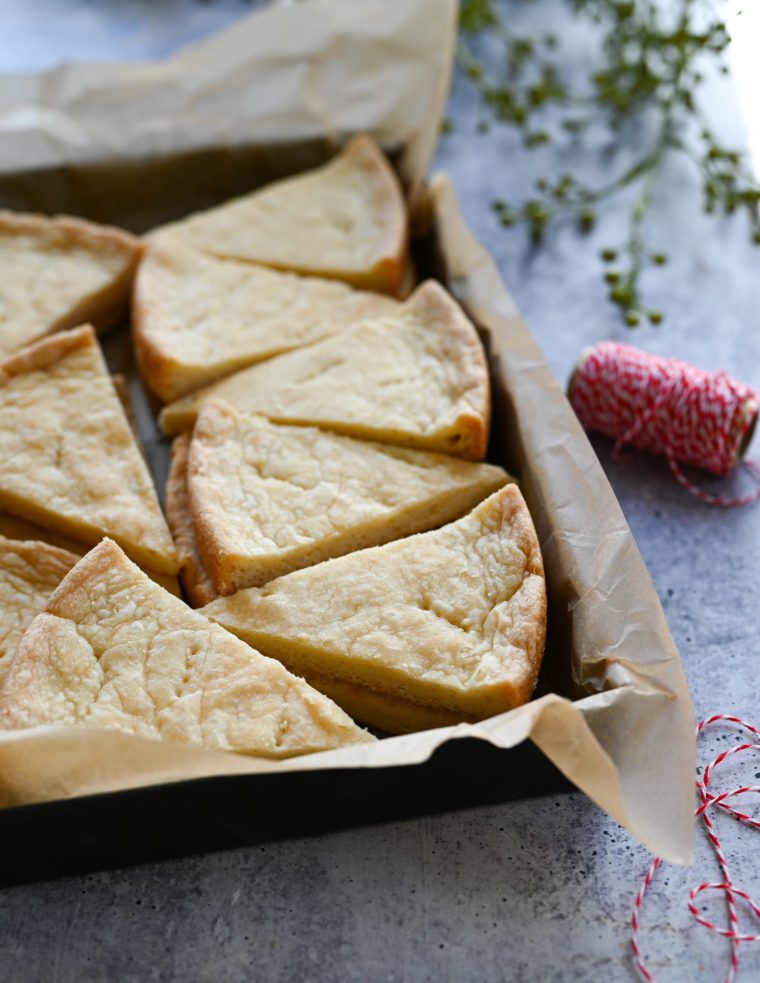
Buttery, crisp, and just sweet enough, classic shortbread cookies are loved for their crumbly texture and rich flavor. They get their name from the generous amount of butter in the dough, which creates that delightful “short” or crumbly texture. (Back in the day, “short” meant crumbly, and the term “shortening” refers to the fat used in making crumbly pastries.) Originally from Scotland, shortbread is often baked in rounds that resemble the sun and then cut into wedges, but you can also bake it in a square pan and cut it into rectangular “fingers.”
These shortbread cookies, adapted from King Arthur Flour, are traditionally served on the winter solstice, Christmas, New Year’s Eve, and New Year’s Day. Once cut, the cookies will keep in an airtight container for up to a month, making them a wonderful treat to bake and give away during the holiday season—or anytime you’re feeling generous, à la Ted Lasso.
“Amazing. Simple. Simply amazing.”
What You’ll Need To Make Shortbread Cookies
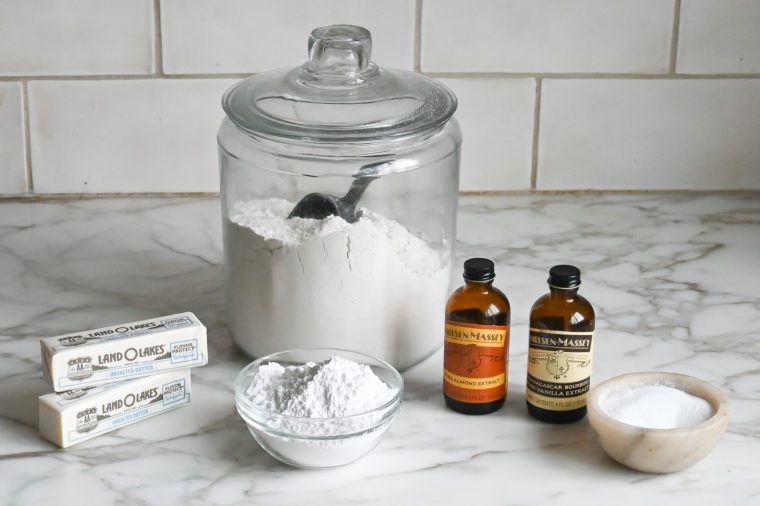
- Butter: Provides richness and flavor to the shortbread.
- Confectioners’ Sugar: Sweetens the shortbread and helps create its delicate crumb texture. Sometimes granulated sugar is used in shortbread, but I prefer confectioners’ sugar as it gives the cookies a softer, melt-in-your-mouth texture.
- Vanilla Extract: Adds a warm and aromatic flavor to the cookies.
- Almond Extract: Infuses a subtle nutty flavor that complements the other ingredients.
- All-Purpose Flour: Forms the base of the dough, providing structure and stability to the shortbread.
- Jump to the printable recipe for precise measurements
Step-By-Step Instructions
In the bowl of a hand-held or stand mixer fitted with the paddle attachment or beaters, combine the butter, sugar, salt, vanilla extract, and almond extract.
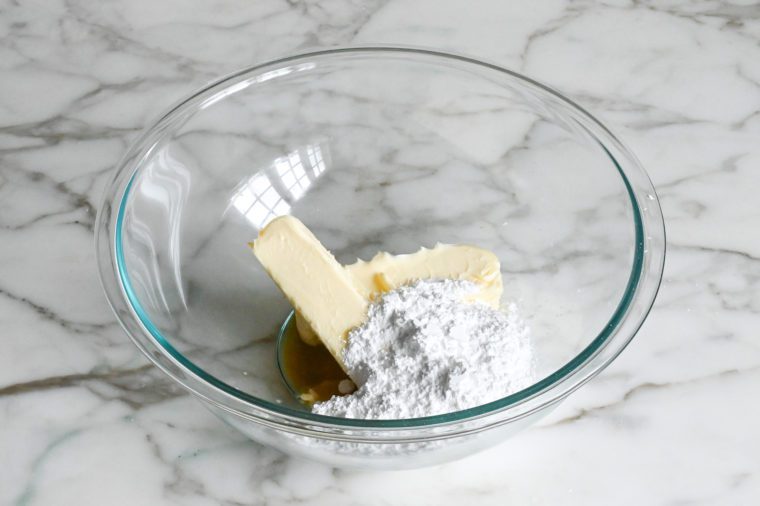
Beat until smooth and creamy, about 1 minute.
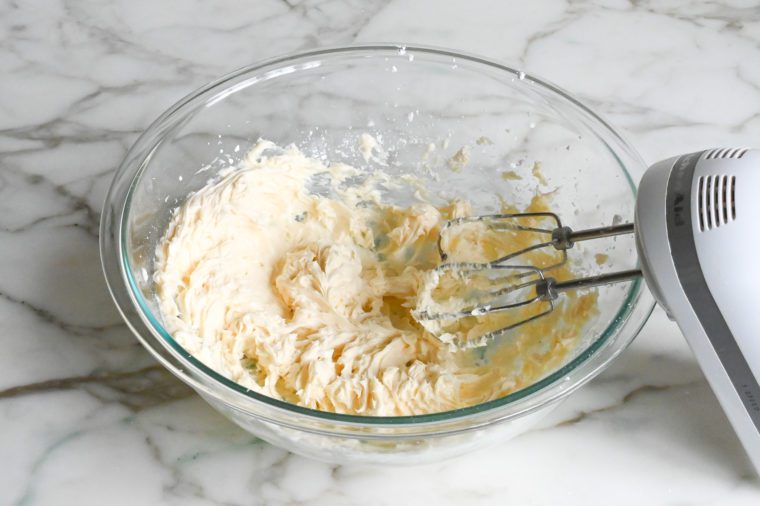 Add the flour.
Add the flour.
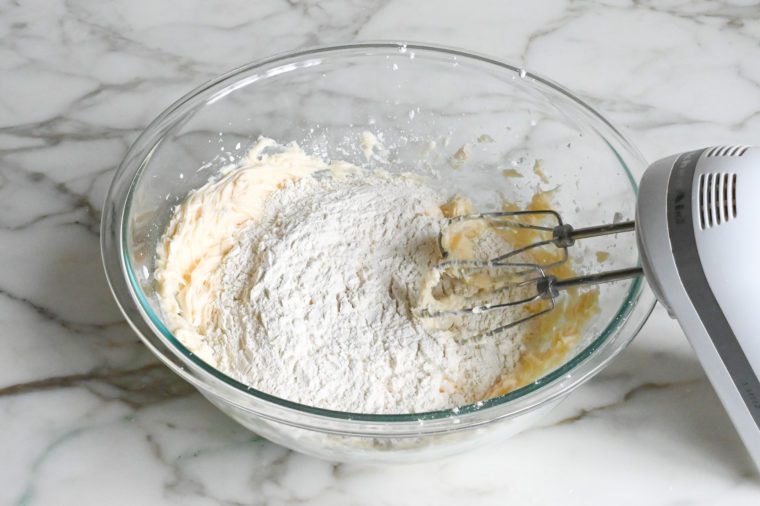
Beat on low speed until the dough comes together in a cohesive mass.
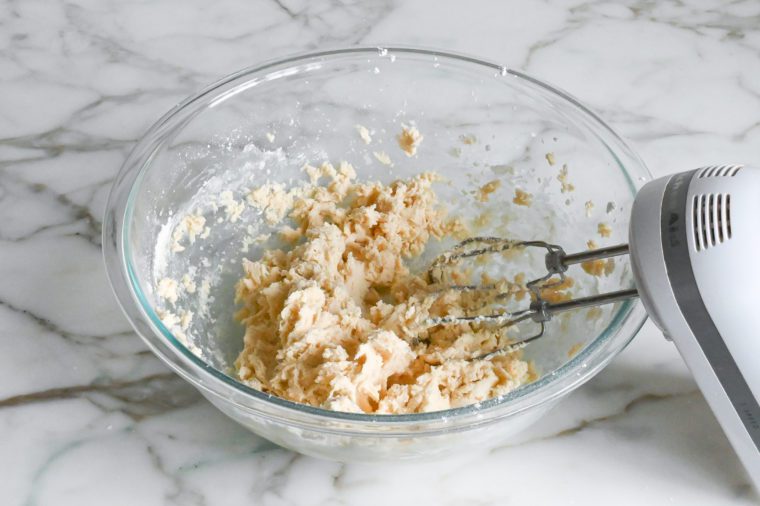
Divide the dough in half (if you have a scale, each half will weigh about 10.5 oz) and place each half in a greased, parchment-lined, 8-inch round cake pan.
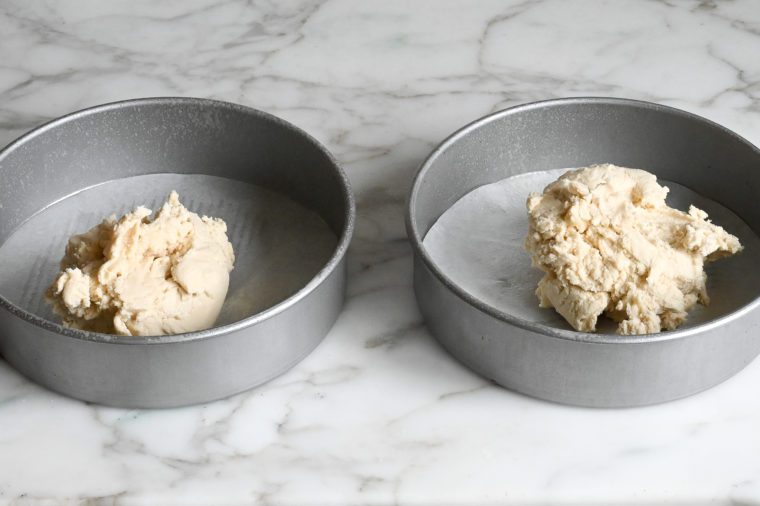
Dust your hands with flour and press each half into an even layer in the prepared pans. To smooth the surface, place a piece of plastic wrap over the dough and smooth with your hands. Use a fork to prick the dough all over in 1-inch intervals. This allows the steam to escape while the shortbread bakes.
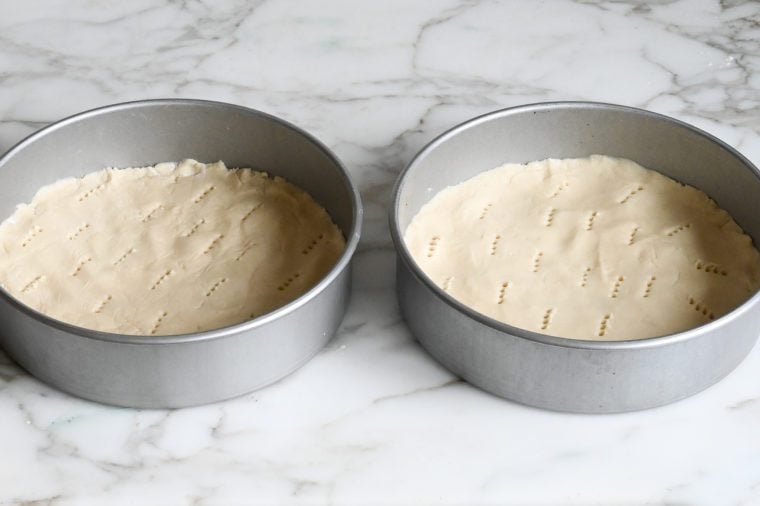
Bake the shortbread in a 300°F oven until it’s a light golden brown across the top surface, and a deeper golden brown around the edges, about 35 minutes. Shortbread should be baked low and slow so that it doesn’t take on much color in the oven. It should remain pale on top and turn slightly golden around the edges.
Remove the pans from the oven, and let cool on a wire rack for about 10 minutes.
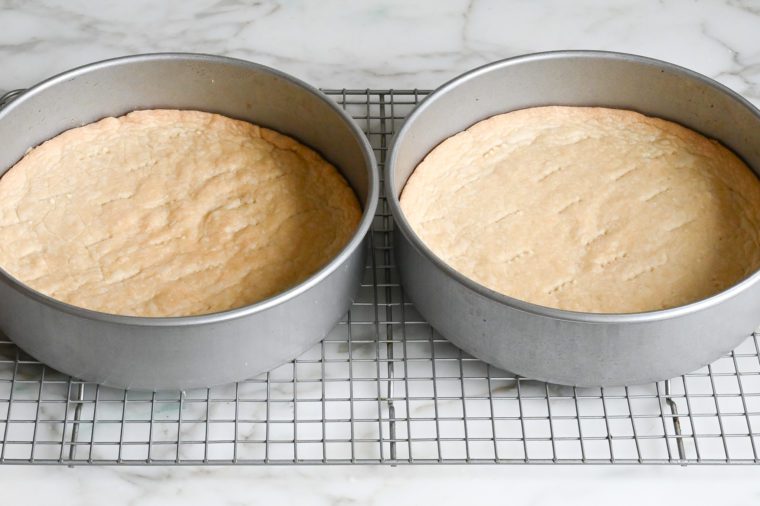
Run a blunt knife around the edges of the pan to loosen the shortbread, and then carefully turn each round out of the pans, using your hand to gently lower the shortbread onto a cutting board.
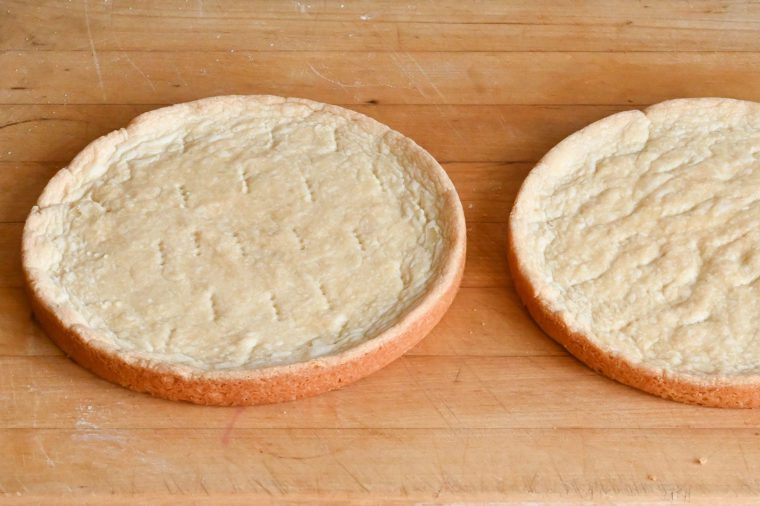
Using a sharp knife, cut each round into 8 or 10 wedges. (Do this while the shortbread is still warm; otherwise, it won’t cut easily and will crumble.)
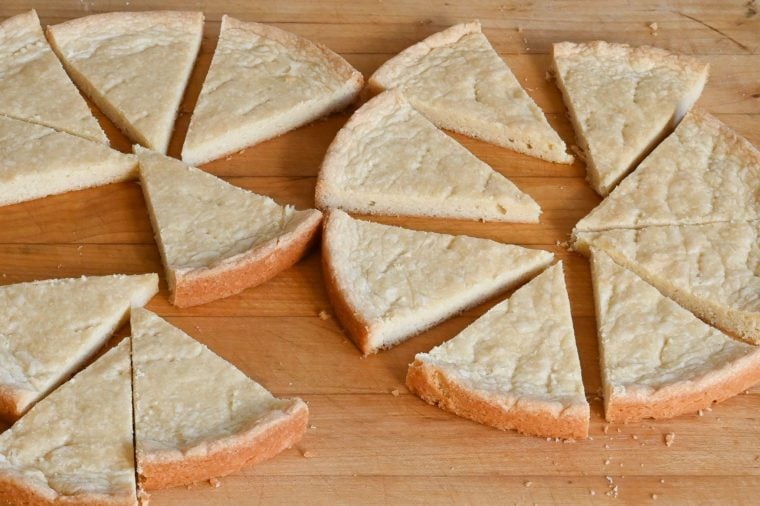
Let the shortbread cool on the cutting board, and then store in an airtight container.
I really enjoy classic shortbread as it’s delicious on its own, but there are also options for bringing a subtle twist to the flavor profile. For a bit of brightness, you might add lemon or orange zest, or for a hint of warmth, try cinnamon. Another way to enhance shortbread is by dipping it in melted chocolate or adding a light dusting of festive sprinkles or coarse sugar before baking, giving it just a touch of flair without taking away from its buttery simplicity.
Make-Ahead, Freezing & Storage Instructions
Shortbread cookies last nicely for up to a month stored in an airtight container at room temperature. This long shelf life makes them ideal for Christmas cookies because they can be enjoyed for weeks after the holidays. And either the dough or the baked cookies can be frozen for up to 3 months. To freeze the dough, shape it into 2 disks, wrap each securely in plastic wrap, and freeze in a sealable bag. When you’re ready to bake, thaw the dough overnight in the refrigerator. To freeze after baking, layer the cookies in an airtight container between sheets of parchment paper or aluminum foil. Thaw the cookies at room temperature before serving.

You May Also Like
Scottish Shortbread
The rich, buttery goodness of shortbread cookies is hard to beat. These delightfully crumbly cookies are perfect for the holidays or any time you’re in the mood for a sweet treat.
Ingredients
- 1 cup (2 sticks) unsalted butter, at room temperature
- 1 cup confectioners sugar
- ½ teaspoon salt
- 2 teaspoons vanilla extract
- ¼ teaspoon almond extract
- 2 cups all-purpose flour, spooned into measuring cup and leveled-off
Instructions
- Preheat the oven to 300°F and set an oven rack in the middle position. Lightly grease two round 8-in cake pans with nonstick cooking spray. Line the pans with parchment rounds, and then spray again.
- In the bowl of an electric mixer fitted with the paddle attachment or beaters, combine the butter, sugar, salt, vanilla extract, and almond extract. Beat until smooth and creamy, about 1 minute. Add the flour beat on low speed until the dough comes together in a cohesive mass.
- Divide the dough in half (if you have a scale, each half will weigh about 10.5 oz). Dust your hands with flour and press each half into an even layer in the prepared pans, dusting your hands with more flour as necessary to prevent the dough from sticking. To smooth the surface, place a piece of plastic wrap over the dough and smooth with your hands. Use a fork to prick the dough all over in 1-inch intervals to allow steam to escape while the shortbread bakes.
- Bake the shortbread until it's a light golden brown across the top surface, and a deeper golden brown around the edges, about 35 minutes.
- Remove the pans from the oven, and let cool on a rack for about 10 minutes. Run a blunt knife around the edges of the pan to loosen the shortbread, and then carefully turn each round out of the pans, using your hand to gently lower the shortbread onto a cutting board. Using a sharp knife, cut each round into 8 or 10 wedges. (Do this while the shortbread is still warm; otherwise, it won't cut easily and will crumble.) Transfer the shortbread wedges to a rack to finish cooling. Store in an airtight container at room temperature for up to 1 month, or freeze for longer storage.
- Freezer-Friendly Instructions: The shortbread dough can be frozen for up to 3 months. After mixing, shape the dough into 2 disks, wrap each securely in plastic wrap, and place them in a sealable bag. Thaw overnight before baking. To freeze the shortbread after baking, store in an airtight container separating layers with parchment paper or aluminum foil. Thaw at room temperature before serving.
Nutrition Information
Powered by ![]()
- Serving size: 1 wedge
- Calories: 152
- Fat: 9 g
- Saturated fat: 6 g
- Carbohydrates: 16 g
- Sugar: 6 g
- Fiber: 0 g
- Protein: 1 g
- Sodium: 60 mg
- Cholesterol: 24 mg
This website is written and produced for informational purposes only. I am not a certified nutritionist and the nutritional data on this site has not been evaluated or approved by a nutritionist or the Food and Drug Administration. Nutritional information is offered as a courtesy and should not be construed as a guarantee. The data is calculated through an online nutritional calculator, Edamam.com. Although I do my best to provide accurate nutritional information, these figures should be considered estimates only. Varying factors such as product types or brands purchased, natural fluctuations in fresh produce, and the way ingredients are processed change the effective nutritional information in any given recipe. Furthermore, different online calculators provide different results depending on their own nutrition fact sources and algorithms. To obtain the most accurate nutritional information in a given recipe, you should calculate the nutritional information with the actual ingredients used in your recipe, using your preferred nutrition calculator.

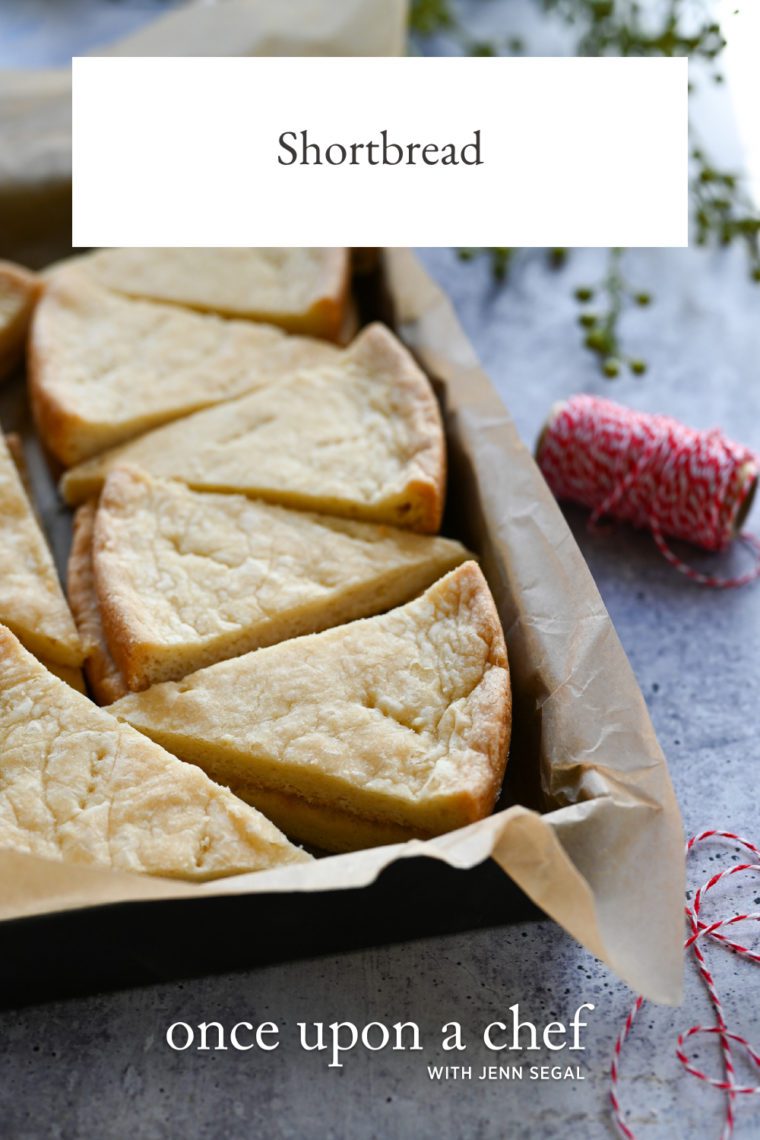
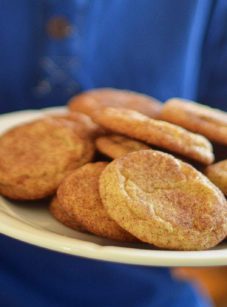
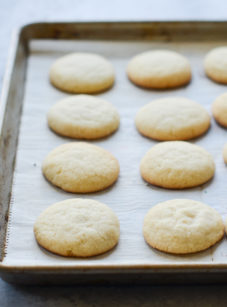
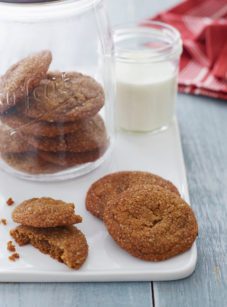
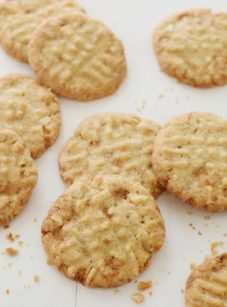
Hi Jenn,
They are baking as I type this. Just realized I only had 8 inch pans. How much longer should I bake? Thanks!
Hi Lisa, I think I’m probably too late with this response, but the shortbread would just take approximately 5 minutes longer. Hope you enjoyed it!
Thanks Jenn! I baked exactly 5 minutes more and they came out perfect!
Made these for our New Year’s day dessert. Simple ingredients and super easy. No problems getting them out of the pan. Husband and neighbors loved, so did I! Jenn, love your recipes.
Because I only have one of the round pans I cut the recipe in half, it was really easy and quick to make. This is delicious!!! My father who is as picky as they come with food said I should make this every week, that it was the best thing I ever baked- lol. Really, this is very delicious to the point that it’s addictive! Thank you so much for this!
Oh my! These are so good! Really easy to make — almost too easy. I see lots of these cookies in my future. My husband thought they were a little rich, but my teenage daughter said she wished she’d never tasted them because now she wants to eat them all. I cut them into smaller strips in hopes that I wouldn’t eat so much at once. Didn’t work. I did have a little trouble getting it out of my pan, and I was using a non stick pan that I buttered. Next time I’ll use parchment paper but I was able to eventually get it out in one piece. Wonderful and easy recipe.
I made these cookies with my sweet 12 yr old granddaughter this morning and they are so buttery and delicious. We are baking another batch to pack in cookie tins for the neighbors. Fabulous!
I just made this. The house smells heavenly!
I only had one 9″ pan. That came out beautifully. The other was on a pie dish. It disintegrated.
Am eating it as I write. It is delicious.
I will certainly make it again. Thank you so much for sharing the recipe.
Hi!
What does ‘cool at room temperature’ means? Does the butter not be mushy? Or it being soft but not too soft.
Hi Sarah, Yes it means soft but not too soft. I’ve changed it to just “room temp” to avoid confusion. Hope that helps!
The shortbread I’ve had from Scotland has always been much thicker than this. Are there different types?
Hi Liz, I’ve seen shortbread in all shapes and sizes – I prefer it thin (this one is about 1/4-inch thick) but it can be made in a smaller pan for a thicker cookie, if you like. You can also use this dough to make shortbread drop cookies (read the baker’s tips at the bottom of the King Arthur recipe here).
THIS is Scottish shortbread…1 cup butter, 1/2 cup sugar, 2 cups flour. Nothing else.
Nancy.. I can’t wait to see your own blog!
Maybe the Scots have slightly different versions like us Italians do for making sauce 🙂 – This is my Scottish former mother-in-law’s grandmother’s recipe: 1 lb (yes, 4 sticks) salted good quality butter at room temp, 4 C flour (not packed), 3/4 C sugar and 1 egg yolk. Mix with wooden spoon (or hands-no mixer), spread in jelly roll pan, make crisis-cross pattern on top with fork prior to baking. Bake in 250 degree oven for 1-1/2 hours. When done, while still warm, lightly sprinkle sugar on top which settles in groves of fork pattern. Cut into squares. Store in tin if there is any left!
Call it shortbread if you must, but most definitely not authentic Scottish shortbread.
Marilyn, Could you possibly give us an example of authentic Scottish shortbread recipe if indeed this is not correct? I thought this particular recipe was spot on.
– LMM
I haven’t tried making it yet, so I’m really not in a position to comment but that doesn’t always stop me! I doesn’t look like the shortbread I’m familiar with, but I’d need to taste it before commenting further. I’d be interesting in Marilyn’s reason for saying it’s not authentic Scottish shortbread.
I completely agree with your comment LMM!
And I don’t know if you read one or two of the comments, but in the comments I’m referring to discusses growing up in Scotland where Shortbread was a kitchen staple. The comments go on to say Jenn’s recipe by far is the best shortbread they’ve ever tasted.
Lisa in Laton
True. Authentic Scottish Shortbread has nothing in it but flour, butter, and sugar. No flavourings of any kind, other than a pinch of salt. No vanilla, no chocolate chips, etc. It is also formed into either fingers, or in a wheel a little less than half an inch thick; with crimped edges to honour the sun. Some people call these petticoat tails. It is also not allowed to brown, but is taken out of the oven when a pale gold.
That’s actually not true, Shortbread cookies dates back to Mary Queen of Scots and
there are many different recipes and regional variations.
Nah Hopflower…
Just like many other foods, numerous variations exist. I lived in Scotland for over a year , and during that time I was in private homes where SHORTBREAD was being made, and no 2 were the same. Different shapes, sizes, some really buttery where it was the star ingredient,while others not so much. Even in the cookbooks I read while there,SHORTBREAD recipes truly VARY.
But w/so many chiming in maintaining Jenn’s recipe is not the “real deal” how do you know,and why is it such an issue?
I’d quit worrying about its authenticity (it is btw), and start baking. I’m a former professional chef , one of my jobs was w/The Ritz Carlton-this recipe hands down is better than any I’ve had before. It’s outstanding.
Lisa in Laton
5 Stars Jenn -another wonderful recipe !